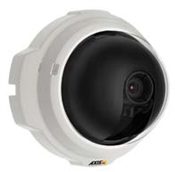Get Rich On IP Video Sales
By Matt Pillar, Business Solutions Magazine
How one Midwestern VAR achieved hard-to-believe growth riding the burgeoning market for cloud-based security-as-a-service.

(Photos by Paul Gates)
What looks like an opportunistic move to exploit a network provider’s glut of bandwidth is actually all part of the plan for Patrick Bailey, EVP at ICS Advanced Technologies (ICS). Sure, the company falls squarely in the reseller realm — particularly in terms of its sales and service of surveillance equipment in the commercial real estate, multi-unit housing, retail, and hospitality markets. However, what sets Bailey’s company apart from most resellers is that ICS got its start selling SaaSbased surveillance solutions to capitalize on the bandwidth patterns it manages on its own network. That network spans more than 23 miles of fiber that ICS has installed primarily in its home area of Ames, IA, but also includes service areas in Illinois, and more recently on the East Coast.
Students Study Late, Stores Open Early
The network ICS manages makes it one of the largest ISPs (internet service providers) in the state of Iowa, serving upwards of 75% of the commercial rental properties in the greater Ames area with a host of network-based services from Direct TV to Internet access to Web-based surveillance. A fair share of those services are sold into student housing, including facilities that house some of the 30,000 students at Iowa State University. It sounds simple, but the daytime network capacity glut that resulted from the need for ultrafast late-night Internet connections for a huge student population has driven incredible opportunity for the reseller side of ICS’s business. “We’re experiencing incredible growth in the B2B arena — particularly among retailers and restaurants — because Internet usage among students peaks from 10 p.m. to 2 a.m.,” explains Bailey. “That’s a perfect match for retailers who want to leverage our network for things like video surveillance, access control, and alarms, which see the majority of their activity during daytime hours.” That excess bandwidth results in the capacity for ICS to deploy in the neighborhood of 8,000 camera feeds before it has to purchase more bandwidth. “That simple reality made going into the retail and hospitality spaces with a SaaS-based security solution very attractive,” he says.
Attractive, indeed. Bailey estimates 2011 growth in security systems for retailers was somewhere between 500% and 700%, with growth continuing at a rate of 50% this year.
Leveraging SaaS For Strategic Server Deployment
Of course, geographic expansion has required ICS to deploy SaaS-based security solutions beyond its own network. In those instances, it procures gigabit connections with local ISPs to connect facilities to its network.
In either case, ICS has had to build its network expertise to accommodate applications that have security and public/life safety implications. “We’ve had to build a resilient network, a system that equipped the VPN-attached devices we deploy with a call-home feature to enable automatic resets and that also features backup and redundancy,” says Bailey. “When you start out doing business in your own town, you’re keenly aware of and prepared for environmental factors — weather, natural disasters, and so on. But, when you expand to new markets, you find you have to respond to a lot more.” Bailey says building redundancy and self-healing attributes into the network has resulted in a ten-fold reduction in weekend emergency calls, despite the company’s rapid geographic growth. “If the power goes out in Cleveland, we’ll instantly get 40 calls from fire alarms. We have to be prepared to deal with that automatically, in such a way that those remote systems continue to operate despite the anomaly,” he says.
Much of that failover capability is a result of the company’s approach to the server architecture that powers its SaaS-based approach to application delivery. Through server virtualization, ICS can deliver high horsepower to world-class applications like surveillance, VoIP, alarms, and access control to small businesses for a moderate cost. “If 5 p.m. is a customer’s peak hour, its servers must be prepared to run at 80% or 90% of capacity for a short period of time. If the rest of the day it’s using only 20% of capacity, those resources are a waste of overhead,” says Bailey. ICS aggregates its cloud-based servers and strategically allocates their resources to match customers’ capacity needs by geography, store clusters, and peak demand times. In the case of video surveillance, for instance, Bailey says retail customers can enjoy the benefits of a $5,000 to $10,000 server for as little as a couple of dollars per camera, per month. “We’ll deliver a lot of value to our retail customers this holiday season, when they realize we can accommodate their server needs even as they extend hours and experience fluctuation in their peak demand times,” he says.
It might sound like the opportunity came along by happenstance, but Bailey insists this has been his vision since launching the company in 2000. “I recently marveled to my wife that we’d come this far,” he recalls, “And she reminded me just how hard we’d been working on it for more than a decade.” For her part, Mrs. Bailey couldn’t be more thrilled that the resilience of the ICS solution has all but eliminated the late-night service calls that were once a cost of doing business.
Barriers To High-Tech Security Adoption
While security solution sales have been robust for ICS, Bailey admits that his company continues to face obstacles. “We’re projecting slower growth for security this year, in the neighborhood of 50%,” he says. Ironically, that slowdown comes hand in hand with the company’s geographic expansion. Many of the markets ICS has broached are not familiar — or in some cases not comfortable — with video surveillance and access control solutions in a SaaS model. “The fire marshal’s regulatory requirements can vary significantly from one jurisdiction or municipality to the next,” warns Bailey, “and local inspectors have different criteria and varying degrees of understanding as well.” If the fire marshal and/or inspector don’t understand the technology, Bailey says it’s incumbent on the solutions provider to teach and demonstrate how the technology meets specific codes and requirements. “Being a bit ahead of the technology curve can sometimes significantly stall projects, but creating awareness and understanding of a new deployment model for systems that ensure life safety is important,” he says.
That said, once a potential customer is handed an iPad and given free reign to discover the power of real-time, remote security systems access, Bailey says the solution virtually sells itself, and the customer becomes an advocate for the new model. “When a potential customer sees firsthand the difference between the solutions we have now and those they used two or three years ago, namely instant, anywhere access to alarms, cameras, and cases over any network, they get excited without much sales pressure. When they realize the cost savings, they typically convert.”
The rapid success of SaaS-based security solutions at ICS has led Bailey to a need for more sales professionals and another unexpected, yet welcome quandary. “With the new system, store designs are more uniform, installation is much simpler and faster, and issue diagnosis and resolution is typically a 15-minute task that’s handled remotely,” he says. In fact, a single ICS engineer recently knocked out seven store installations in five different cities in a single week, with between-location drive times between two and four hours. “These efficiencies result in a massive cost savings for our customers. Two years ago, a camera outage could have taken five days to resolve between scheduling, drive time, diagnosis, and repair,” Bailey explains. Today, we can charge a premium for remote maintenance and still save the customer money, but because most issues take 10 to 15 minutes to fix, we need to update our accounting and ticketing systems,” he says. “We’re not currently designed to account for time at that granular a level, so we’ll have to change that.” Just like being ahead of the times on security sales, it’s a nice problem for ICS to have.

